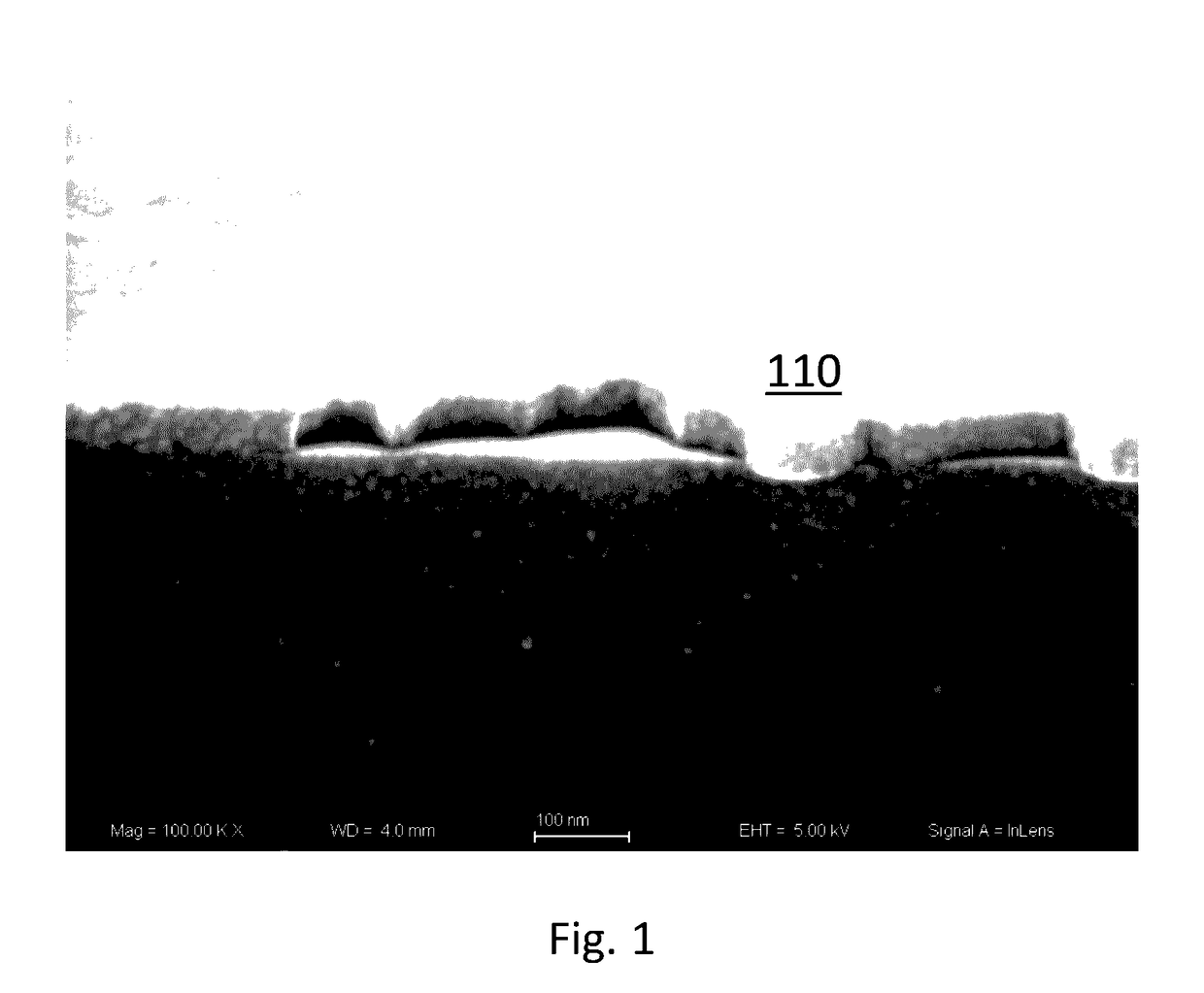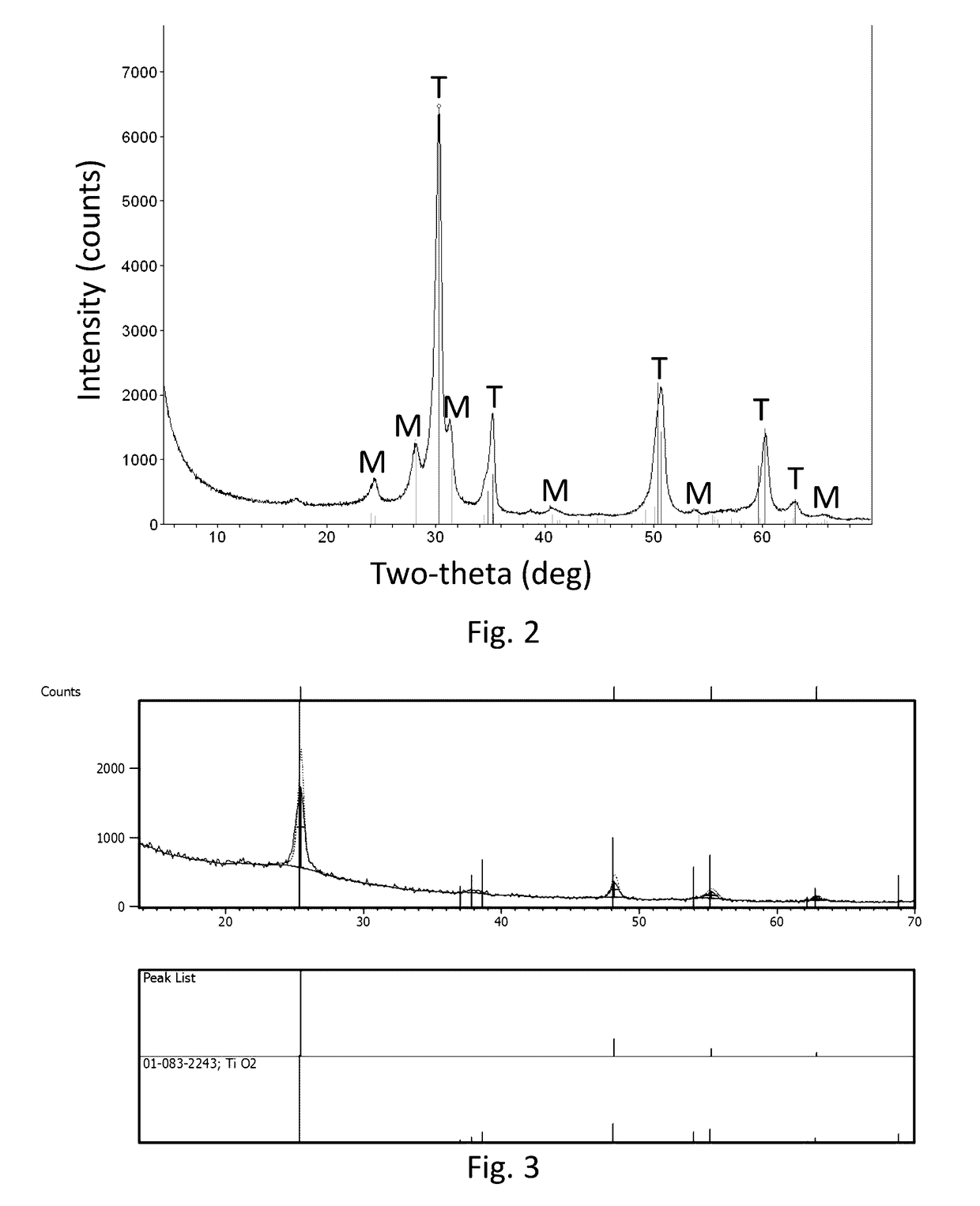Scratch-resistant liquid based coatings for glass
a technology of liquid based coatings and glass, applied in the direction of liquid/solution decomposition chemical coatings, coatings, transportation and packaging, etc., can solve the problems of reducing the brightness and contrast of images and text, hazy display, marred and unattractive, etc., to improve durability and lifetime, high hardness, and low coefficient of friction
- Summary
- Abstract
- Description
- Claims
- Application Information
AI Technical Summary
Benefits of technology
Problems solved by technology
Method used
Image
Examples
example 1
[0072]Zirconia (ZrO2) and titania (TiO2) coatings were prepared by spin-coating respective solutions onto glass substrates. For zirconia, a 1.9M solution of zirconium oxychloride octahydrate in DMF was used. For titania, a 1.6M solution (1:1 vol. %) of titanium isopropoxide in DMF was used. Both solutions were prepared under nitrogen. Coatings were formed by spin-coating the solutions onto a substrate at 4000 rpm for 30 sec. Annealing and crystallization of the as-deposited coatings was done at 475° C. for 5 min.
[0073]As shown in the x-ray diffraction data in FIG. 2, the zirconia coating is primarily tetragonal (T) zirconia, though reflections consistent with monoclinic (M) zirconia are also observed. The x-ray data for the titania coating (FIG. 3) index to the anatase polymorph of titanium oxide.
example 2
[0074]Optical transmission spectra for zirconia coatings are shown in FIG. 4. The examples include (A) zirconia, (B) zirconia doped with graphene, (C) zirconia doped with nickel, and (D) zirconia doped with carbon nanotubes. The transmission spectrum of an uncoated glass substrate (E) is shown for reference.
[0075]The zirconia coating was formed from a 1.9M solution of zirconium oxychloride octahydrate in DMF. For the graphene-doped and carbon nanotube-doped coatings, from 0.1 mg / ml to 1.6 mg / ml of graphene or single-walled carbon nanotube (SWCNT) particles were added to the zirconium oxychloride octahydrate solution prior to spin-coating. For the zirconia doped with nickel, a 1:1 volume ratio solution was prepared comprising zirconium oxychloride octahydrate in DMF (1.9M) and nickel acetylacetonate in DMF (0.25M).
[0076]Transmission through the uncoated glass substrate was nearly 100%. The zirconia coating, with opposing air and glass boundaries, forms an etalon. The interference man...
example 3
[0077]Atomic force microscopy (AFM) data are shown in FIG. 5 for two different zirconia coatings. FIG. 5A shows a 10×10 micron2 grid for a zirconia coating formed from a 1.9M solution of zirconium oxychloride octahydrate in DMF. FIG. 5B shows a 2×2 micron2 grid for a graphene-doped (1.6 mg / ml) zirconia coating formed from a 0.95M solution of zirconium oxychloride octahydrate in DMF. Additional solvent was added to the graphene-doped solution to decrease the molarity. Post-deposition, both samples were annealed and crystallized at 450° C. for 15 min. The coefficient of friction of the graphene-doped coating was less than the coefficient of friction of the zirconia-only coating.
PUM
| Property | Measurement | Unit |
|---|---|---|
| width | aaaaa | aaaaa |
| particle size | aaaaa | aaaaa |
| particle size | aaaaa | aaaaa |
Abstract
Description
Claims
Application Information
 Login to View More
Login to View More - R&D
- Intellectual Property
- Life Sciences
- Materials
- Tech Scout
- Unparalleled Data Quality
- Higher Quality Content
- 60% Fewer Hallucinations
Browse by: Latest US Patents, China's latest patents, Technical Efficacy Thesaurus, Application Domain, Technology Topic, Popular Technical Reports.
© 2025 PatSnap. All rights reserved.Legal|Privacy policy|Modern Slavery Act Transparency Statement|Sitemap|About US| Contact US: help@patsnap.com



